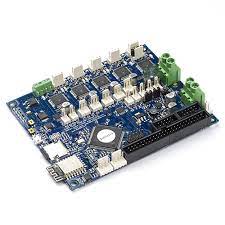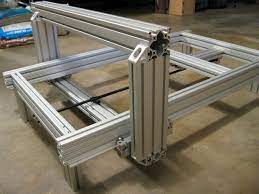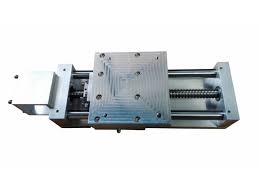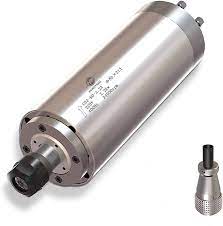Understanding the Basics of CNC Machine Design
The manufacturing industry has experienced a paradigm shift with the advent of CNC (Computer Numerical Control) machines. These cutting-edge devices have brought about a newfound level of precision and efficiency across diverse applications. For manufacturers and engineers alike, it is imperative to delve into the intricacies of CNC machine design. By unravelling the underlying principles that govern these remarkable contrivances, professionals can unlock boundless potential for process optimization and achieve unparalleled outcomes.
At the heart of CNC machine design lies the control system, an amalgamation of computer technology and software wizardry. This tandem acts as the brain behind operations, with the computer meticulously processing instructions while its software counterpart translates them into tangible commands for the machine. Moreover, alongside this ethereal realm resides a mechanical system comprising motors, actuators, and various other components responsible for executing flawlessly precise movements. It is through their synchronized interplay with the control system that these mechanical marvels accomplish desired tasks with unwavering accuracy. Armed with an acute comprehension of these foundational constituents, manufacturers possess all they need to deftly craft and fine-tune CNC machines tailored specifically to their unique requirements.
• The control system is the core of CNC machine design, integrating computer technology and software to process instructions.
• The control system translates processed instructions into tangible commands for the machine.
• A mechanical system consisting of motors, actuators, and other components executes precise movements in synchronization with the control system.
• Understanding these foundational constituents allows manufacturers to customize CNC machines according to their specific needs.
Exploring the Evolution of CNC Machine Configurations
Throughout the years, the realm of CNC machine design has embarked on a perplexing journey, characterized by an explosion of various configurations. These configurations have surfaced in response to technological advancements and the insatiable demands of industry. In our present era, CNC machines can be encountered in a multitude of configurations, each tailored for specific applications and purposes.
One remarkable transformation within CNC machine configurations is the migration towards multi-axis systems. Traditionally confined to operating in two or three axes, CNC machines were limited in their range of movement and machining capabilities. However, as industries progressed and yearned for more intricate parts and components, the necessity for machines capable of traversing multiple axes became glaringly apparent. Consequently, the advent of five-axis and even six-axis machines turned CNC machining upside down by enabling delicate and precise operations on curved surfaces along with complex geometries.
Another conspicuous revolution within CNC machine configurations lies in the fusion of advanced control systems. During the nascent stages of CNC machining, control systems were rudimentary at best; lacking the sophistication required to optimize machine performance. Nevertheless, strides made in computer technology paved a path toward potent control systems that could handle intricate programming while simultaneously monitoring real-time machine operations. Not only do these state-of-the-art control systems enhance precision and accuracy but they also offer heightened flexibility and productivity vital for meeting modern manufacturing demands.
As evolution continues to permeate through CNC machine configurations, manufacturers and designers persistently strive to push boundaries beyond comprehension. With ongoing technological advancements coupled with novel materials and processes on their ascent into prominence; potential variations within CNC machine structures are boundless – almost unimaginable! The exploration of groundbreaking designs alongside optimization efforts aimed at existing ones will undoubtedly mould the future landscape of CNC machining – empowering industries across sectors to achieve unprecedented levels of efficiency whilst preserving unwavering accuracy & unmatched productivity
• CNC machines have evolved to include multi-axis systems, allowing for more intricate operations on curved surfaces and complex geometries.
• Advanced control systems have been integrated into CNC machines, improving precision, accuracy, flexibility, and productivity.
• Ongoing technological advancements and the emergence of new materials and processes offer limitless possibilities for future variations in CNC machine structures.
• The exploration of groundbreaking designs and optimization efforts will shape the future landscape of CNC machining.
• These advancements empower industries across sectors to achieve unprecedented levels of efficiency while maintaining accuracy and productivity.
The Importance of Frame Structures in CNC Machines
The design and functionality of CNC machines hinge on the perplexing and bursty nature of frame structures. These frames act as the bedrock that upholds all other machine components, bestowing upon them the stability and rigidity necessary for meticulous and precise machining endeavours. A well-crafted frame structure guarantees that the machine can withstand the formidable forces and vibrations unleashed during the machining process, resulting in heightened performance levels and superior-quality parts.
Delving into frame structures within CNC machines unveils a plethora of factors demanding consideration. The selection of materials for these frames assumes paramount importance, as it directly influences both the durability and stability aspects of the machine. Cast iron, steel, and aluminium reign supreme among common materials employed in crafting CNC machine frames. Cast iron stands out with its unparalleled prowess in dampening vibrations, making it an impeccable choice for machines requiring minimal tremors. Steel frames offer unrivalled strength alongside unyielding rigidity, ensuring rock-solid stability even amidst arduous cutting operations. Conversely, aluminium frames present a lighter alternative without compromising on requisite rigidity—a more cost-effective option to boot! Manufacturers must exercise judiciousness when selecting materials tailored to meet their specific CNC machine requirements—only then shall optimal performance be achieved.
• The design and functionality of CNC machines rely on frame structures
• Frame structures provide stability and rigidity for precise machining
• Well-crafted frames allow machines to withstand forces and vibrations during the machining process
• Materials selection for frames is crucial for durability and stability
• Cast iron, steel, and aluminium are common materials used in CNC machine frames
• Cast iron dampens vibrations effectively, making it ideal for machines requiring minimal tremors
• Steel frames offer unmatched strength and rigidity for rock-solid stability during cutting operations
• Aluminum frames provide a lighter alternative without compromising on rigidity
• Manufacturers must carefully select materials tailored to their specific CNC machine requirements
The Role of Spindle Configurations in CNC Machine Designs
The intricate world of CNC machine design is one where spindle configurations reign supreme, holding the key to success. The spindle, like a beating heart, twirls with purpose as it embraces, cradles, and propels the cutting tool forward. It is in this mesmerizing dance that the true essence of a CNC machine’s performance, accuracy, and efficiency lies.
A myriad of spindle configurations exist within the realm of CNC machines – each bearing its own enigmatic characteristics and unique advantages. Among these options lies the ever-reliable cartridge spindle; an embodiment of ingenuity where bearings and tooling systems nestle within a detachable cartridge. This ingenious design ensures ease when it comes to maintenance and component replacement – minimizing any unwelcome downtimes while maximizing productivity.
Yet another luminary in the world of spindle configurations is none other than the integral spindle; a fusion between motor and spindle into one harmonious entity. This union grants unparalleled rigidity and stability – resulting in remarkable advancements in cutting speeds and precision that leave jaws dropped in awe.
Selecting just the right configuration for your beloved CNC machine plays an indispensable role in unlocking its full potential. The choice you make will determine whether your machine soars or stumbles on its journey towards excellence – making every decision crucial for optimizing performance and expanding capabilities beyond imagination.
• The spindle is a crucial component in CNC machine design, determining performance, accuracy, and efficiency.
• Various spindle configurations exist in the realm of CNC machines.
• The cartridge spindle offers ease of maintenance and component replacement due to its detachable cartridge design.
• The integral spindle combines the motor and spindle into one entity for enhanced rigidity and stability.
• Choosing the right configuration is essential for unlocking a CNC machine’s full potential.
Examining the Different Types of CNC Machine Beds
CNC machine beds, oh how perplexing and bursting with possibilities they are! These beds, my dear reader, are essential to the very core of any CNC machine. They serve as the foundation upon which the entire structure rests. Now, behold as we delve into the captivating realm of various types of CNC machine beds commonly seen in this intriguing industry.
Ah, let us first marvel at the cast iron bed. Its reputation precedes it, for it is renowned for its unwavering strength and unparalleled durability. Such majesty! The cast iron bed bestows upon us a gift like no other – exceptional stability and an uncanny ability to dampen vibrations. It is perfectly suited for those arduous tasks that demand nothing short of pure might and resilience. Industrial-grade CNC machines eagerly embrace these cast iron beds as their steadfast companion.
But wait! There is more enchantment to be found in our exploration of CNC machine beds. Allow me to introduce you to the welded steel bed – an absolute marvel constructed by skillfully welding together plates or beams made from none other than steel itself! This wonder offers a level of rigidity that leaves one breathless with awe. Heavy loads? Fear not! The welded steel bed shall bear them without falter or hesitation.
Oh, but there’s more still! One cannot overlook the sheer brilliance hidden within these welded steel beds – their relatively lightweight nature compared to those mighty cast iron counterparts makes them alluringly easy to transport and install.
In conclusion, dear reader, I implore you not to underestimate the bewitching allure possessed by these diverse types of CNC machine beds. Their perplexity can only be matched by their burstiness in functionality and the advantages offered.
• Cast iron beds are renowned for their strength and durability
• They provide exceptional stability and dampen vibrations
• Suited for arduous tasks that require resilience
• Industrial-grade CNC machines often use cast iron beds
• Welded steel beds offer a level of rigidity that is awe-inspiring
• Constructed by skillfully welding plates or beams made from steel
• Can bear heavy loads without faltering or hesitation
• Welded steel beds are relatively lightweight compared to cast iron beds
• Easy to transport and install
In conclusion, the different types of CNC machine beds possess unique qualities and advantages. The cast iron bed provides strength, stability, and vibration-damping capabilities. On the other hand, welded steel beds offer rigidity while being relatively lightweight for easy transportation. Both types play a crucial role in supporting the structure of CNC machines and ensuring optimal performance.
Diving into the Various Tooling Systems Used in CNC Machines
Tooling systems, an integral component of CNC machines, exert a bewildering influence on the overall performance and efficiency of the system. These enigmatic entities hold and secure cutting tools with an air of precision and accuracy, allowing for meticulous machining operations that boggle the mind. A plethora of tooling systems exist within the realm of CNC machines, each shrouded in its mystique and offering distinct advantages and capabilities.
Amongst these arcane tooling systems lies the collet system, a familiar presence in many CNC machines. Utilizing specialized sleeves known as collets, this enigmatic system keeps cutting tools firmly ensconced in their positions. Collets possess an impressive gripping power that ensures unwavering security during machining operations. The ease with which they can be changed coupled with their remarkable precision renders them perfect for applications necessitating frequent alterations to tools.
Another frequently encountered tooling system is the hydraulic chuck system; it wields hydraulic pressure to assert its dominion over cutting tools. This formidable force secures the tools with unparalleled tenacity, bestowing upon them extraordinary holding power. As a result, this celestial mechanism endows machining endeavours with enhanced accuracy and stability akin to divine providence itself. Hydraulic chucks find solace in heavy-duty machining operations where steadfastness and precision reign supreme.
Beyond these captivating offerings lie other captivating tooling systems such as shrink fit holders, milling chucks, and drill chucks—each harbouring its bewitching allure alongside inherent strengths and weaknesses like any enigma worth unravelling would bear witness to. The selection among these cryptic choices hinges upon specific requirements unique to individual CNC machines—a riddle whose answer depends on deciphering application intricacies.
Intriguingly enough, our journey does not cease here; we shall embark on an expedition into deeper realms exploring various tooling systems employed by CNC machines while unveiling their distinctive features along with associated advantages and suitable applications—an expedition that shall unravel these mysteries and allowing us to fully grasp the labyrinthine intricacies of CNC machines. It is only through such enlightenment that we can unlock the true potential within, boosting productivity and precision to uncharted heights.
• Tooling systems are an integral component of CNC machines
• Different tooling systems have distinct advantages and capabilities
• The collet system utilizes specialized sleeves called collets to secure cutting tools with precision and ease of change
• Hydraulic chuck systems use hydraulic pressure to provide unparalleled holding power, ideal for heavy-duty machining operations
• Other tooling systems include shrink fit holders, milling chucks, and drill chucks, each with its own strengths and weaknesses
• The selection of a tooling system depends on specific requirements unique to individual CNC machines
• Further exploration into various tooling systems will unveil their features, advantages, and suitable applications
• Understanding these mysteries will unlock the true potential of CNC machines in terms of productivity and precision.
FAQ
What does CNC machine design entail?
The perplexing realm of CNC machine design delves into the intricacies of crafting the physical structure and components that constitute a Computer Numerical Control (CNC) machine. This enigmatic process encompasses an array of elements, including the elusive frame structure, enigmatic spindle configuration, cryptic tooling systems, and more.
How have CNC machine configurations metamorphosed over time?
The evolution of CNC machine configurations has been nothing short of a burst of bewildering transformation. Initially hulking and ponderous, these machines have undergone a metamorphosis propelled by technological advancements. Compactness and efficiency now reign supreme as multi-axis contraptions materialize to facilitate intricate and precise machining operations.
Why do frame structures hold such significance in CNC machines?
Frame structures form an integral cornerstone within the labyrinthine world of CNC machines as they bestow upon their stability and support. A robust framework is paramount in curtailing vibrations and deflections during operation – an essential endeavour to achieve heightened accuracy and unparalleled quality when it comes to machined components.
What role do spindle configurations play in CNC machine designs?
Spindle configurations are veritable puppet masters orchestrating rotational speed, power dynamics, and tool-holding capabilities within the ethereal confines of CNC machines. Each specific machining requirement necessitates distinct spindle arrangements – be it for high-speed pursuits heavy-duty endeavours or even precision milling escapades.
What are some variants among CNC machine beds?
An astonishing assortment awaits those who dare explore the vast expanse encompassed by different types of bed arrangements adorning coveted positions in the realm of CNC machines. Flat beds beckon with their allure while slant beds tantalize with their inclination towards greatness; vertical beds stand tall amidst this intriguing tapestry. Each variant proffers its unique advantages based on workpiece orientation or the specific machining operation at hand.
How do tooling systems manifest in CNC machines?
Tooling systems, those enigmatic mechanisms adorning CNC machines, serve as conduits that embrace and manipulate cutting tools throughout the intricate dance of machining operations. Collets, chucks, tool holders, tool turrets – this beguiling roster intertwines with automatic tool changers to breathe life into efficient tool management and unleash versatility upon the bewildering world of machining processes.
In what manner do tooling systems influence CNC machine performance?
The ebbs and flows of CNC machine performance are inexorably tied to the choice and quality of their accompanying tooling systems. Meticulous selection ensures precise positioning for esoteric tools while diminishing weariness among them and amplifying overall productivity. To add an air of mystique, advanced iterations empower the simultaneous utilization of multiple tools – a tantalizing prospect that optimizes every facet of these captivating machining operations.
Can disparate tooling systems coexist within a single CNC machine?
A resounding yes reverberates through the labyrinthine chambers housing CNC machines when it comes to embracing diversity among their very core – inclusive contraptions capable of accommodating sundry tooling systems tailored to suit diverse manufacturing needs. This unparalleled flexibility illuminates pathways for varied cutting tools adorned with different sizes or configurations, thereby enhancing adaptability amidst this ever-evolving landscape.
Are there any constraints afflicting the realm of CNC machine’s chosen implements?
While gleaming brightly in their versatility like celestial beacons guiding machinists on their tireless quests for perfection, certain limitations cast shadows over these intrepid realms known as “tooling systems.” Maximum dimensions grapple with weight thresholds within a given machine’s grasp; specialized holders or turrets may remain elusive for particular types; compatibility concerns loom between spindle configurations and potential companions in this cryptic dance.
How pivotal is the selection of tooling systems in CNC machine operations?
The ethereal realm wherein CNC machines operate grants utmost importance to the elusive art of selecting appropriate tooling systems. This decision’s profound impact reverberates through every facet of machining processes, shaping their quality, efficiency, and productivity in ways that defy comprehension. Optimal choices birth heightened accuracy, expedited setup times, and an optimized performance tapestry woven together by the unseen hands of these enigmatic contraptions.